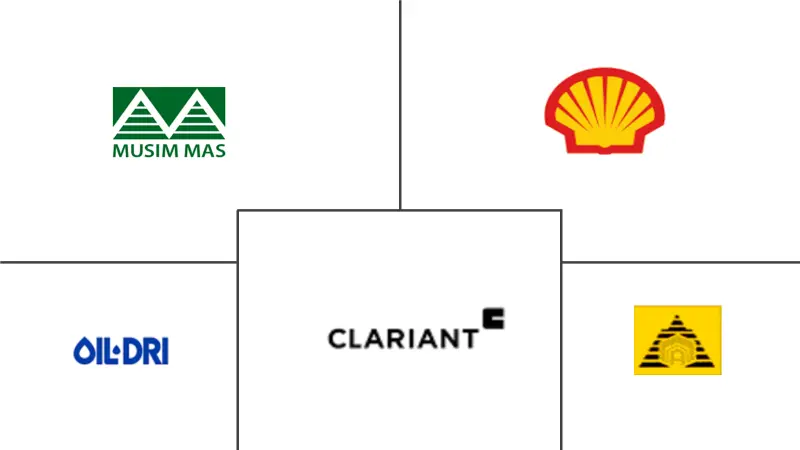Activated Bleaching Earth Market Size and Share
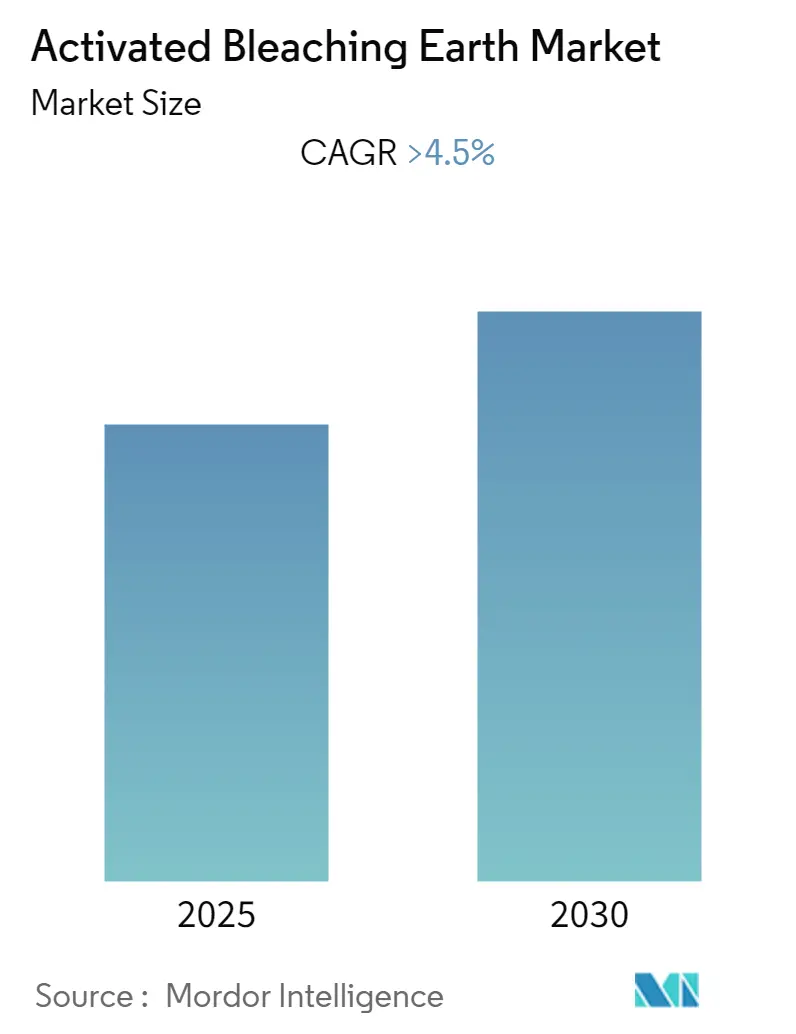
Activated Bleaching Earth Market Analysis by Mordor Intelligence
The Activated Bleaching Earth Market is expected to register a CAGR of greater than 4.5% during the forecast period.
The activated bleaching earth industry is experiencing significant transformation driven by robust growth in global vegetable oil production and consumption patterns. According to the US Department of Agriculture, global vegetable oil production reached 217.62 million metric tons in 2022/23, representing a 4.21% increase from the previous year, while consumption grew to 213.08 million metric tons. The OECD-FAO Agricultural Outlook projects vegetable oil production to reach 246.9 megatons by 2030, indicating sustained long-term growth potential for the activated bleaching earth market. This growth trajectory is further supported by increasing industrialization in developing economies and rising demand for processed food products globally.
The industry is witnessing substantial investments and consolidation activities, particularly in Asia and the Middle East. In March 2023, ExxonMobil announced plans to construct a manufacturing facility in India with an investment of approximately USD 110 million, aimed at producing 159,000 kiloliters of finished lubricants annually. Similarly, in November 2022, Shell Eastern Petroleum acquired EcoOils Limited, strengthening its position in the sustainable feedstock market and expanding its capabilities in spent bleaching earth oil processing. These strategic moves indicate growing industry confidence and commitment to expanding production capabilities.
Technological advancements in bleaching earth activation processes and increasing focus on product efficiency are reshaping industry dynamics. Manufacturers are investing in research and development to develop specialty bleaching earth products that can lower the amount of 3-chloropropane-1,2-diol (3-MCPD) in edible oils and fats, responding to stringent food safety requirements. The industry is also witnessing innovations in both dry and wet bleaching processes, with wet bleaching methods gaining attention despite higher initial costs due to their superior efficiency in reducing bleaching earth consumption and oil loss.
Sustainability initiatives and circular economy practices are becoming increasingly prominent in the industry. Companies are developing eco-friendly neutral grades entirely devoid of harmful acids and implementing comprehensive multilevel control processes across unit operations. The trend toward sustainable practices is exemplified by EcoOils' process of recycling waste and producing spent bleaching earth oil, which serves as an advanced biofuel feedstock. This focus on sustainability is driving innovation in product development and processing techniques, while also opening new market opportunities in the renewable energy sector.
Global Activated Bleaching Earth Market Trends and Insights
Growing Demand for Edible Oils
The increasing global demand for edible oils has emerged as a primary driver for the bleaching earth market, as this material plays a crucial role in the refining and purification process of various edible oils. The global production volumes of major edible oils have shown significant growth, with palm oil production reaching 77.22 million metric tons in 2022/23, up from 73.83 million metric tons in 2021/22. Similarly, soybean oil production increased by 3.0% to 61,494 thousand metric tons, while rapeseed oil production grew to 31.8 million metric tons in 2022/23. This substantial increase in edible oil production directly correlates with the rising demand for activated bleaching earth, as it is essential for removing impurities, color pigments, and unwanted substances from these oils.
The versatility of activated bleaching earth in purifying various types of edible oils has further strengthened its market position. The material is extensively used in the purification of a wide range of oils, including soybean oil, cottonseed oil, palm oil, rapeseed oil, sunflower oil, safflower oil, rice bran oil, corn oil, canola oil, olive oil, and sesame oil. The superior absorption capabilities of bleaching clay compared to natural bleaching earths make it particularly valuable in the edible oil industry. This is evidenced by recent industry developments, such as the significant retail price increase for vegetable oil, which grew by 67% from March 2021 to January 2023, indicating strong market demand. Additionally, the material's crucial role in enhancing oil quality by removing gums (phospholipids), free fatty acids, soap contents, and traces of heavy metals has made it indispensable in the bleaching earth for edible oil refining process.
Segment Analysis: Application
Edible Oils and Fats Segment in Activated Bleaching Earth Market
The edible oils and fats segment continues to dominate the global activated bleaching earth market, commanding approximately 79% of the total market share in 2024. This substantial market position is primarily driven by the increasing global demand for refined edible oils across various food applications. The segment's dominance is reinforced by bleaching earth's crucial role in removing impurities, color pigments, and harmful substances from edible oils, ensuring high-quality end products with improved shelf life. The material's effectiveness in eliminating substances that promote rancidity and spoilage, while also neutralizing free fatty acids in crude oils, has made it indispensable in the edible oil refining process. Furthermore, the growing health consciousness among consumers and their preference for high-quality, refined cooking oils has sustained the segment's market leadership position.
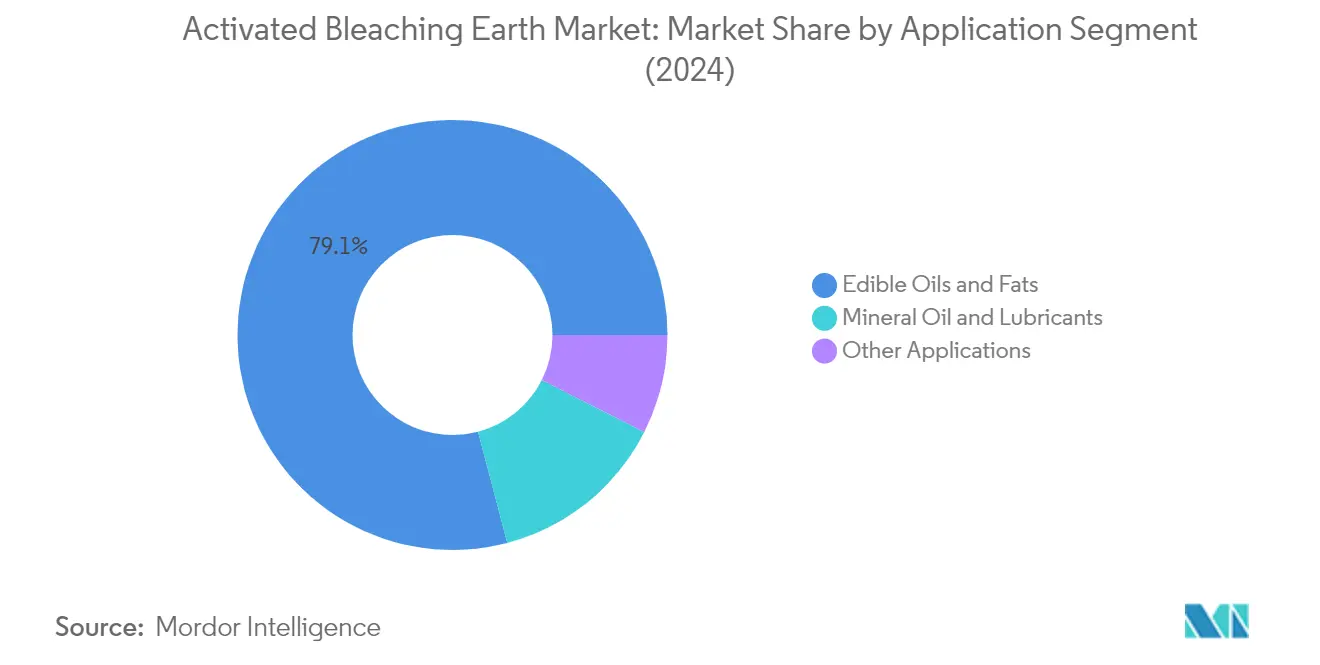
Mineral Oil and Lubricants Segment in Activated Bleaching Earth Market
The mineral oil and lubricants segment is projected to experience robust growth at approximately 5% CAGR during the forecast period 2024-2029. This growth trajectory is primarily attributed to the increasing demand for refined mineral oils and lubricants across various industrial applications. The segment's expansion is driven by the rising need for high-quality lubricants in the automotive and industrial sectors, coupled with a growing emphasis on recycling and purification of used oils. The effectiveness of activated bleaching earth in removing colored substances, impurities, and contaminants from mineral oils and lubricants has made it an essential component in the refining process. Additionally, the material's superior performance in recycling synthetic and mineral oils, particularly engine oil, where the recycled product can achieve better quality than the original base oil, is contributing to its increased adoption in this segment.
Remaining Segments in Application
Other applications of activated bleaching earth encompass diverse industries, including chemicals, biodiesel production, and various industrial processes. These applications leverage the material's exceptional absorption capabilities for specialized purification needs. The segment's significance is particularly notable in the biodiesel industry, where acid activated bleaching earth plays a crucial role in the purification process. Additionally, its applications extend to wastewater treatment, agricultural chemical carriers, and various industrial dehydrating processes. The versatility of bleaching clay in these applications, combined with its effectiveness in removing dioxins from garbage incineration plants and its utility as a carrier for agricultural chemicals, continues to drive its adoption across different industrial sectors.
Activated Bleaching Earth Market Geography Segment Analysis
Activated Bleaching Earth Market in Asia-Pacific
The Asia-Pacific region represents the dominant activated bleaching earth market, driven by the substantial presence of edible oil processing industries and growing industrial applications. China, India, Japan, and South Korea are the key markets in this region, with each country showcasing distinct market dynamics and growth patterns. The region's bleaching earth market is characterized by increasing demand from both traditional and emerging applications, supported by robust manufacturing capabilities and technological advancements in the bleaching earth production process.
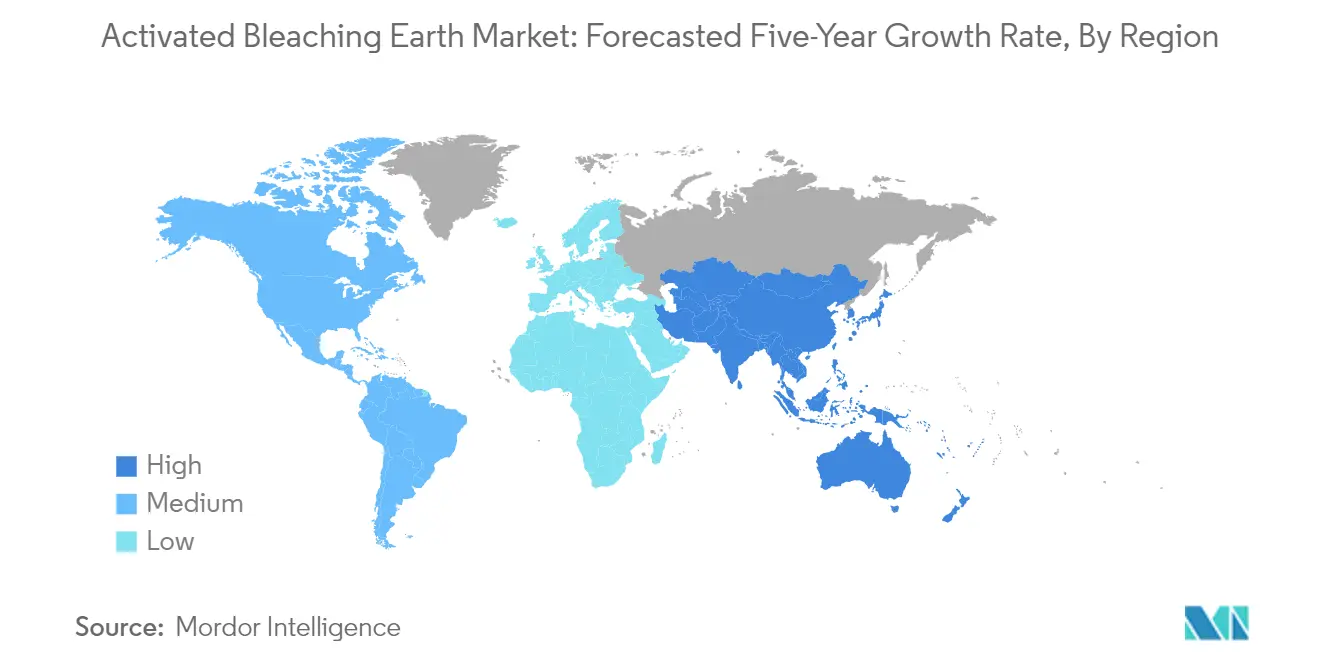
Activated Bleaching Earth Market in China
China stands as the powerhouse in the Asia-Pacific activated bleaching earth market, commanding approximately 28% of the regional activated bleaching earth market share in 2024. The country's market is primarily driven by its massive edible oil processing industry and growing industrial applications. China's position is strengthened by its extensive manufacturing base, well-established supply chains, and significant investments in processing capabilities. The country's market is further supported by its robust domestic demand for refined oils and fats, particularly in the food processing sector. The presence of major manufacturers and continuous technological advancements in bleaching earth production has helped maintain China's dominant position in the regional market.
Activated Bleaching Earth Market in India
India emerges as the fastest-growing market in the Asia-Pacific region, with a projected growth rate of approximately 6% during 2024-2029. The country's market is experiencing rapid expansion due to increasing industrialization and growing demand from the edible oil processing sector. India's market growth is supported by rising domestic consumption of refined oils, an expanding food processing industry, and government initiatives promoting industrial development. The country has also witnessed significant investments in manufacturing capabilities and technological upgrades, positioning it as a key growth driver in the regional activated bleaching earth market. The presence of both domestic and international players has created a competitive environment, fostering innovation and market expansion.
Activated Bleaching Earth Market in North America
The North American activated bleaching earth market demonstrates a mature and well-structured landscape, with the United States, Canada, and Mexico as the primary markets. The region's market is characterized by high technological adoption, stringent quality standards, and sophisticated end-user industries. The presence of major manufacturers, advanced research and development facilities, and well-established distribution networks contributes to the region's market stability and growth potential.
Activated Bleaching Earth Market in United States
The United States dominates the North American market, holding approximately 63% of the regional market share in 2024. The country's market leadership is attributed to its advanced industrial infrastructure, large-scale oil refining operations, and diverse end-user applications. The U.S. market benefits from continuous technological innovations, strong research and development activities, and the presence of major industry players. The country's robust regulatory framework and high-quality standards have established it as a benchmark for product quality and performance in the global bleaching earth market.
Activated Bleaching Earth Market in Canada
Canada emerges as the fastest-growing market in North America, with a projected growth rate of approximately 5% during 2024-2029. The country's market is driven by increasing investments in oil processing infrastructure and growing demand from various industrial applications. Canada's market growth is supported by its strong focus on sustainable practices, technological advancement in manufacturing processes, and expanding end-user industries. The country's strategic location and trade relationships have facilitated market expansion and enhanced its position in the regional supply chain.
Activated Bleaching Earth Market in Europe
The European activated bleaching earth market presents a sophisticated landscape with Germany, the United Kingdom, Italy, and France as key markets. The region's market is characterized by high technological standards, a strong focus on sustainable practices, and stringent quality regulations. The presence of established manufacturers, advanced research facilities, and well-developed distribution networks contributes to the market's stability and growth potential.
Activated Bleaching Earth Market in Germany
Germany maintains its position as the largest market in Europe, driven by its robust industrial base and advanced manufacturing capabilities. The country's market leadership is supported by its strong presence in oil processing and refining industries, coupled with high technological adoption rates. Germany's market benefits from continuous innovations in processing technologies and a strong emphasis on product quality and performance standards.
Activated Bleaching Earth Market in France
France emerges as the fastest-growing market in Europe, driven by increasing investments in industrial infrastructure and growing demand from various end-user industries. The country's market growth is supported by a strong focus on technological advancement, sustainable practices, and expanding applications in different industrial sectors. France's strategic position in the European market and strong research and development capabilities contribute to its growth momentum.
Activated Bleaching Earth Market in South America
The South American activated bleaching earth market is experiencing significant growth, with Brazil and Argentina emerging as key markets in the region. Brazil leads the regional market as the largest consumer, while Argentina shows the highest growth potential. The region's market is driven by expanding edible oil processing industries, growing industrial applications, and increasing investments in manufacturing capabilities. The presence of both domestic and international players, coupled with improving industrial infrastructure, contributes to the market's development. The region's rich agricultural base and growing food processing industry provide substantial opportunities for market expansion.
Activated Bleaching Earth Market in Middle East & Africa
The Middle East & Africa market for activated bleaching earth demonstrates growing potential, with Saudi Arabia and South Africa as significant markets. South Africa leads the regional market in terms of market size, while Saudi Arabia shows promising growth prospects. The region's market is driven by expanding industrial infrastructure, growing oil processing activities, and increasing investments in manufacturing capabilities. The presence of major oil processing industries, coupled with a growing focus on quality enhancement in industrial processes, supports market development. The region's strategic location and improving economic conditions contribute to its market growth potential.
Competitive Landscape
Top Companies in Activated Bleaching Earth Market
The activated bleaching earth market is characterized by companies focusing on continuous product innovation and technological advancement in their manufacturing processes. Companies are investing in research and development to develop more efficient bleaching earth products with enhanced adsorption capabilities and sustainability features. Operational agility is demonstrated through strategic partnerships with raw material suppliers and the establishment of robust distribution networks across key regions. Market leaders are expanding their geographical presence through capacity expansions, particularly in Asia-Pacific where demand is highest. Strategic moves include vertical integration to secure raw material supply, development of eco-friendly product variants, and investments in sustainable production methods. Companies are also focusing on developing specialized grades for specific applications like edible oils and mineral oils, while simultaneously working on improving product efficiency and reducing waste generation.
Market Structure Shows Mixed Global-Local Dynamics
The global activated bleaching earth industry exhibits a fragmented structure with a mix of large multinational corporations and regional specialists. Leading players like Clariant and Musim Mas have established a strong global presence through extensive manufacturing networks and distribution channels, while regional players maintain significant market share in their respective territories through local expertise and customer relationships. The market demonstrates moderate consolidation with the top players holding substantial market share, though numerous medium and small-scale manufacturers continue to serve specific regional markets or specialized applications.
Recent market dynamics show increasing merger and acquisition activities, particularly focused on expanding geographical presence and acquiring technological capabilities. Major companies are pursuing strategic acquisitions to strengthen their position in high-growth markets, as evidenced by Shell's acquisition of EcoOils Limited to enhance their sustainable fuel capabilities. The industry is witnessing a trend toward consolidation as larger players seek to expand their product portfolio and geographic reach through strategic partnerships and acquisitions, while simultaneously maintaining focus on technological advancement and sustainability initiatives.
Innovation and Sustainability Drive Future Success
For incumbent companies to maintain and expand their market share, focus needs to be placed on developing innovative products with enhanced performance characteristics while simultaneously improving sustainability credentials. Companies must invest in research and development to create more efficient bleaching earth products that reduce waste generation and energy consumption during the refining process. Building strong relationships with key end-users in the edible oil and mineral oil sectors, while expanding into emerging applications like biofuels, will be crucial for maintaining competitive advantage. Additionally, establishing robust supply chain networks and implementing vertical integration strategies will help ensure consistent raw material supply and quality control.
For contenders looking to gain ground in the market, focusing on specialized product offerings and regional market opportunities presents a viable strategy. New entrants must differentiate themselves through technological innovation, superior customer service, or cost advantages while building strong relationships with local customers. The relatively low threat of substitution products provides stability, though companies must remain vigilant about potential technological disruptions. Regulatory compliance, particularly regarding environmental standards and waste management, will become increasingly important as sustainability requirements become more stringent. Success will depend on balancing operational efficiency with environmental responsibility while maintaining product quality and customer relationships.
Activated Bleaching Earth Industry Leaders
-
Clariant
-
Musim Mas
-
Shell
-
Oil-Dri Corporation of America
-
Ashapura Perfoclay Limited
- *Disclaimer: Major Players sorted in no particular order
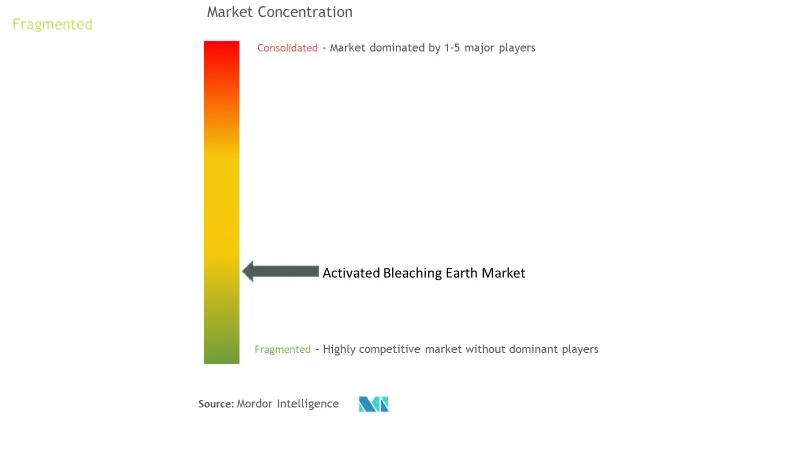
Recent Industry Developments
- November 2022: Shell Eastern Petroleum (Pte) Ltd, a wholly-owned subsidiary of Shell PLC (Shell), acquired EcoOilsLimited (EcoOils), a waste oil recycling company. This acquisition is part of Shell's goal to enhance the production of low-carbon transportation fuels, particularly sustainable aviation fuel. EcoOilsMalaysia's subsidiaries and 90% of its Indonesian subsidiary will be acquired. EcoOilsuse recycling technology prevents waste from going to landfills and produces spent bleaching earth oil, an internationally recognized biofuels feedstock that can be used to produce low-carbon fuels.
Global Activated Bleaching Earth Market Report Scope
Activated bleaching earth is utilized in the refining, purification, and discoloration of edible and non-edible oils and fats. It is also referred to as wash clay. Activated bleaching earth is generally composed of clay minerals such as bentonite and attapulgite.
The activated bleaching earth market is segmented by application and geography. By application, the market is segmented into edible oil and fats, mineral oil and lubricants, and other applications. The report also covers the market size and forecasts in 15 countries across major regions. For each segment, the market sizing and forecasts have been done on the basis of value (USD).
| Edible Oil and Fats |
| Mineral Oil and Lubricants |
| Other Applications (Chemical, Biodiesel, etc.) |
| Asia-Pacific | China |
| India | |
| Japan | |
| South Korea | |
| Rest of Asia-Pacific | |
| North America | United States |
| Canada | |
| Mexico | |
| Europe | Germany |
| United Kingdom | |
| Italy | |
| France | |
| Rest of Europe | |
| South America | Brazil |
| Argentina | |
| Rest of South America | |
| Middle East and Africa | Saudi Arabia |
| South Africa | |
| Rest of Middle East and Africa |
| Application | Edible Oil and Fats | |
| Mineral Oil and Lubricants | ||
| Other Applications (Chemical, Biodiesel, etc.) | ||
| Geography | Asia-Pacific | China |
| India | ||
| Japan | ||
| South Korea | ||
| Rest of Asia-Pacific | ||
| North America | United States | |
| Canada | ||
| Mexico | ||
| Europe | Germany | |
| United Kingdom | ||
| Italy | ||
| France | ||
| Rest of Europe | ||
| South America | Brazil | |
| Argentina | ||
| Rest of South America | ||
| Middle East and Africa | Saudi Arabia | |
| South Africa | ||
| Rest of Middle East and Africa | ||
Key Questions Answered in the Report
What is the current Activated Bleaching Earth Market size?
The Activated Bleaching Earth Market is projected to register a CAGR of greater than 4.5% during the forecast period (2025-2030)
Who are the key players in Activated Bleaching Earth Market?
Clariant, Musim Mas, Shell, Oil-Dri Corporation of America and Ashapura Perfoclay Limited are the major companies operating in the Activated Bleaching Earth Market.
Which is the fastest growing region in Activated Bleaching Earth Market?
Asia Pacific is estimated to grow at the highest CAGR over the forecast period (2025-2030).
Which region has the biggest share in Activated Bleaching Earth Market?
In 2025, the Asia Pacific accounts for the largest market share in Activated Bleaching Earth Market.
What years does this Activated Bleaching Earth Market cover?
The report covers the Activated Bleaching Earth Market historical market size for years: 2019, 2020, 2021, 2022, 2023 and 2024. The report also forecasts the Activated Bleaching Earth Market size for years: 2025, 2026, 2027, 2028, 2029 and 2030.
Page last updated on:
